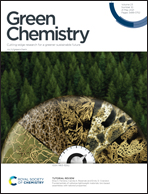Enhancing the multi-functional properties of renewable lignin carbon fibers via defining the structure–property relationship using different biomass feedstocks†
Abstract
Lignin has been explored extensively as a renewable precursor for carbon materials, considering its abundance as a major component of plant cell walls and its sustainability as a byproduct of both lignocellulosic biorefinery and the paper-making industry. Despite the extensive efforts to define the process–property relationship, it remains largely unknown how lignin biosynthesis and its chemistry would impact the resultant carbon fiber properties, for both mechanical and electroconductive performances. Such inadequate understanding fundamentally limits feedstock design and selection to improve carbon fiber properties toward broader commercial applications. Using lignin from a broad range of biomass feedstocks for carbon fiber manufacturing, we have fundamentally explored the structure–function relationship between lignin chemistry and carbon fiber performance. Specifically, lignin extracted from hardwood (sugar maple), softwood (loblolly pine and red cedar), and herbaceous plants (corn stover and switchgrass) was used for carbon fiber manufacturing, considering the very different lignin structures from these feedstocks. Linear regression models were established to define the relationship between carbon fiber mechanical properties and lignin structural characteristics. The results highlighted that the content of β-O-4 linkages correlates significantly with the tensile strength and elastic modulus of lignin carbon fibers, indicating that more linear β-O-4 linkages would promote the carbon fiber mechanical performance. Moreover, electroconductive properties are essential for broader energy device application of lignin-based carbon fibers, yet the mechanisms controlling their electroconductivity are largely unknown. We hereby demonstrated that a higher β-O-4 content also promotes the electroconductivity of lignin carbon fibers. Microstructure analysis further revealed that the crystallite size and content of the pre-graphitic turbostratic carbon structure in lignin-based carbon fibers were enhanced as the β-O-4 linkages increased. The content of β-O-4 linkages has shown a strong correlation with the crystallite content in a linear regression model. This study thus revealed the underlying mechanisms regarding how the lignin structure in planta defines the resultant carbon fiber properties. Moreover, the study also highlighted the correlation between the mechanical and electroconductive properties of lignin-based carbon fibers, both of which were defined by the lignin structure.



 Please wait while we load your content...
Please wait while we load your content...